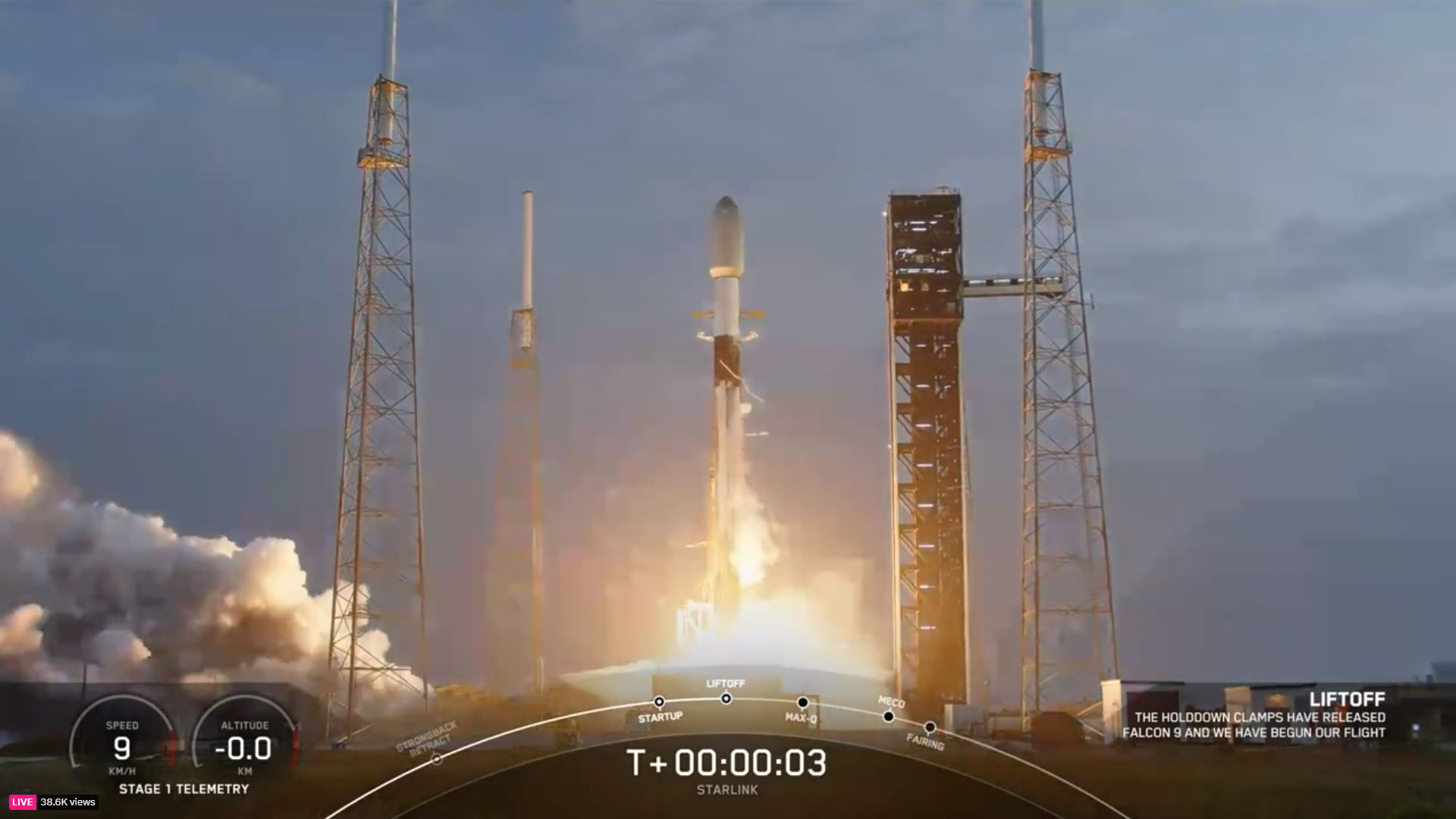
“Launch Week” is officially underway on the Space Coast, following Monday’s post-sunset rise of a SpaceX Falcon 9 booster from storied Space Launch Complex (SLC)-40 at Cape Canaveral Space Force Station, Fla., as United Launch Alliance (ULA) counts down to the final liftoff of its triple-barreled Delta IV Heavy—and the swansong of the veteran Delta fleet after more than six decades of operational service—out of neighboring Space Launch Complex (SLC)-37B as early as 1:40 p.m. EDT Thursday. It was SpaceX’s tenth Falcon 9 launch so far in March, tying with January for the greatest number of missions across the span of a single calendar month.

First out of the gate was SpaceX’s veteran B1078 booster, making her second outing of the year so far, which becomes the 16th Falcon 9 core since January 2021 to reach an eighth launch. Blackened and scorched from her seven prior ascents and high-energy re-entries, B1078 sprang onto SpaceX’s scene last March, when she launched Dragon Endeavour and her Crew-6 quartet of NASA astronauts Steve Bowen and Warren “Woody” Hoburg, Russian cosmonaut Andrei Fedyayev and Sultan Al-Neyadi of the United Arab Emirates (UAE) to begin their six-month increment aboard the International Space Station (ISS).
Returning from her maiden voyage, B1078 went on to fly five more times last year, delivering a pair of O3b mPOWER broadband communications satellites into orbit late in April for Luxembourg-headquartered SES and four batches of Starlink low-orbiting internet communications satellites between June and December. Each of her six 2023 missions terminated with on-point touchdowns on the expansive deck of the Autonomous Spaceport Drone Ship (ASDS), situated offshore in the Atlantic Ocean.

Kicking off 2024, she rose again on Valentine’s Day to transport the U.S. Space Force’s highly secretive USSF-124 payload of six discrete spacecraft—two Hypersonic and Ballistic Tracking Space Sensor (HBTSS) satellites for the Missile Defense Agency (MDA) and the final four Tranche 0 Transport and Tracking Layer (TTL) satellites for the Space Development Agency (SDA)—into orbit. That launch concluded with B1078’s first touchdown on solid ground at the Cape’s Landing Zone (LZ)-2.
In readiness for Monday’s launch, the drone ship “A Shortfall of Gravitas” put to sea out of Port Canaveral on Saturday, bound for a recovery position some 390 miles (630 kilometers) offshore in the Atlantic Ocean. And on Monday, SpaceX announced that it was targeting a three-hour “window” of T-0 opportunities, extending from 5:52 p.m. EDT through 9 p.m. EDT, with backup options on Tuesday that opened at 5:24 p.m. EDT.

The weather outlook for both attempts looked favorable, with about a 95-percent Probability of Go (PGo), tempered on Monday by a potential violation of the Cumulus Cloud Rule and on Tuesday by a slight chance of infringing the Thick Cloud Layers Rule. Weather conditions pertaining to the safe oceanic recovery of the booster were also categorized in the “Low-Moderate”.
“Models show an extensive low-topped stratocumulus deck piling into the Spaceport going into the primary launch window Monday afternoon,” reported the 45th Weather Squadron at Patrick Space Force Base, “but it is expected that these clouds will pose little to no launch weather threat as they remain relatively warm and the very dry air above the surface limits cloud growth.” Similarly, a new frontal system expected to move through the central Gulf of Mexico on Tuesday was expected to remain far enough to the west to not be an overarching worry.

As Monday progressed, T-0 was refined to 7:42 p.m. EDT, affording teams a shorter period of 78 minutes to get the tenth Falcon 9 of March off the ground. “All systems are ready and weather is go,” SpaceX tweeted shortly before 7 p.m.
Fueling of the 230-foot-tall (70-meter) booster got underway on time at T-35 minutes, as around a million pounds (450,000 kilograms) of liquid oxygen and a highly refined form of rocket-grade kerosene—known as “RP-1”—were loaded aboard the booster’s tanks. A minute before launch, as those tanks pressurized for flight, B1078’s on-board computer assumed primary control of vehicle critical functions, an event dubbed “Startup”.

Liftoff occurred precisely on time at 7:42 p.m. EDT, the exhaust of the nine Merlin 1D+ engines casting a dull orange glow over the Florida landscape. Two and a half minutes into the mission, her job done, B1078 separated from the stack and completed a picture-perfect descent to JRTI’s deck, alighting at just past eight minutes past liftoff.
Meanwhile, the single Merlin 1D+ Vacuum engine of the second stage burned for a customary six minutes to deliver the mission’s 23 Starlinks safely into orbit. As this AmericaSpace story was being prepared, deployment was targeted to occur 65 minutes into the flight.

Tonight’s launch brings to almost 430 the total of these flat-packed internet-proving satellites launched on 19 of the 29 Falcon 9 missions so far in 2024. And more than 6,000 Starlinks have so far been lofted to orbit by 149 Falcon missions (including tonight’s) since May 2019.
As a network, Starlink enables high-speed and low-latency internet provision to over 70 sovereign nations and international markets in North and South America, Europe, Asia, Oceania and Africa. Landlocked Eswatini—formerly Swaziland—in southern Africa and Honduras and Paraguay joined Starlink in December and SpaceX revealed that network availability was extended to Mongolia in March 2024.

The downsized V2 Mini satellites, first flown in February of last year, boast three to four times greater “usable” bandwidth than earlier Starlink iterations. “V2 Minis include key technologies—such as more powerful phased-array antennas and the use of E-Band for backhaul—which will allow Starlink to provide 4x more capacity per satellite than earlier iterations,” SpaceX explained. “Among other enhancements, V2 Minis are equipped with new argon Hall thrusters for on-orbit maneuvering.”
Florida-based intercity operator Brightline adopted Starlink on its trains in 2023, the first passenger rail service in the world to do so. Additionally, El Salvador’s Ministry of Education has begun integrating Starlink capability into its schools to help close the digital divide between urban and remote rural communities and 50 Rwandan schools are now connected via Starlink’s high-speed internet service.

And in January, SpaceX lofted its first six “Direct-to-Cell” Starlinks, which permit mobile network providers to offer “seamless global access to texting, calling and browsing”, whether “on land, lakes or coastal waters”, without the need to change hardware or firmware. Within six days of that first launch, SpaceX engineers sent and received their first text messages via Direct-to-Cell and as of March Starlink reportedly has about 2.6 million registered subscribers or customers worldwide.
Attention now turns to neighboring SLC-37B at the Cape, where ULA is readying its self-styled “Most Metal of Rockets”, the Delta IV Heavy, for its swansong mission as early as Thursday, 28 March, to deploy the highly classified NROL-70 payload for the National Reconnaissance Office. On Sunday, ULA and the NRO jointly announced that they are targeting a T-0 of 1:40 p.m. EDT for the 389th and last launch of the Delta rocket family, which traces its ancestry back over six decades to the first flight of a modified Thor missile with a Delta second stage way back on 13 May 1960.

From that first flight, which failed to insert the Echo-1 communications satellite into orbit following a malfunction in the upper stage’s attitude control system, the fleet enjoyed an overall 95-percent success rate and evolved through multiple iterations, most recently the Delta II, which retired in September 2018 following the ICESat-2 mission, and the Delta IV Medium which made its final voyage a year later to deliver the second Block III Global Positioning System (GPS) into orbit, leaving only the triple-barreled Delta IV Heavy to fly five final flights for the NRO between December 2020 and this month.
The Delta’s earliest missions included Echo-1, the first passive communications satellite, launched in August 1960, and Telstar-1, which furnished the first live-broadcasted television pictures between the United States and Europe in July 1962. Deltas also lofted the world’s first geosynchronous-orbiting communications satellite, Syncom-2, in July 1963, as well as Intelsat-1—the famous “Early Bird”—which delivered near-instantaneous transcontinental television and telephone broadcasts for the first time after its April 1965 launch.

In addition to communications, Deltas delivered missions ranging from meteorology to solar science, atmospheric and magnetospheric physics and space research to Earth resources and life sciences. Key payloads included Solar Max in February 1980—a Sun-observing spacecraft later repaired by shuttle astronauts in April 1984—plus the Infrared Astronomical Satellite (IRAS) in January 1983 and the Near-Earth Asteroid Rendezvous (NEAR) mission, launched in February 1996 to visit, orbit and explore asteroid 433 Eros.
Members of the Delta family also kicked off multiple voyages to the Red Planet: the Mars Pathfinder with its historic Sojourner rover in December 1996, the Spirit and Opportunity rovers in the summer of 2003 and the Phoenix lander in August 2007. Other missions of deep-space inquiry included the Spitzer space telescope—the last of NASA’s fleet of “Great Observatories”— and the MErcury Surface, Space ENvironment, GEochemistry and Ranging (MESSENGER) voyage to the Sun’s closest planet.

The Delta IV Heavy, for its part, has been a relatively recent addition to this decades-old fleet of rocket. The triple-barreled behemoth entered service in December 2004 and with NROL-70 will have logged 16 launches, tasked with delivering 12 classified payloads uphill for the NRO, as well as the final Defense Support Program (DSP) early-warning satellite in November 2007, the Exploration Flight Test (EFT-1) of NASA’s Orion spacecraft in December 2014 and the Parker Solar Probe in August 2018.
But the weather gods might not be aligned for the second half of this week, with only a 30-percent probability of acceptable conditions on Thursday, nudging upwards slightly to 60-percent-favorable on Friday. The forecast includes broken low-level and mid-level clouds, scattered showers, good visibility, northwesterly winds 20-25 knots and a temperature close to 24 degrees Celsius (75 degrees Fahrenheit).

“A front approaching from the northwest Wednesday night will bring clouds and a high likelihood of showers, possibly a few thunderstorms to the area Thursday morning into the early afternoon,” said Launch Weather Officer (LWO) Mark Burger of the 45th. “The potential for one or more weather violations on the primary launch day is set well above the climatological average.”





